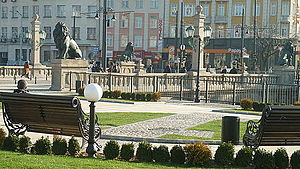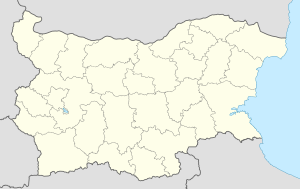Lion Bridge (Sofia)
Coordinates: 42 ° 42 ′ 18 ″ N , 23 ° 19 ′ 26 ″ E
| Lion Bridge (Sofia) | ||
|---|---|---|
| Official name | Лъвов мост | |
| use | Pedestrians and trams | |
| Convicted | Knyaginya Maria-Luiza Boulevard | |
| Subjugated | Vladayska reka | |
| place | Sofia | |
| construction | stone arch bridge | |
| overall length | about 26 m | |
| width | 18 m | |
| start of building | 1889 | |
| location | ||
|
|
||
The Lion Bridge ( Bulgarian Лъвов мост / Lavow most) in the Bulgarian capital Sofia is the most famous bridge in the city , along with the Eagle Bridge .
The bridge is one of the sights of Sofia and the symbol of Sofia's Serdika district. In Bulgaria it is officially listed as a cultural monument in the architectural and art monument category.
The Scharen most bridge (Bulgarian Шарен мост ) stood in front of the Lion Bridge at this point ; Bulgarian for Colorful Bridge or Sandakli most (Bulgarian Сандъкли мост ). Colorful bridge because its paint consisted of yellow and red stripes.
location
The Lion Bridge is located in the center of Sofia, on the important north-south traffic axis , the Boulevard Knjaginia Maria Luisa , which connects the immediate city center with the main train station . It crosses the Vladaya River (Bulgarian Владайска река ) north of the city center, halfway between the Central Market Hall in Sofia and the Central Station. The bridge is an important and busy intersection in the center of Sofia at the intersection of Knjaginia Marie Louisa and Slivnitsa Boulevard .
description
The stone bridge consists of two arches, 26 m long and 18.1 m wide. The bridge is decorated with four bronze lions that stand on pedestals and gave the bridge its name. The bronze lions were made by the Viennese company Rudolph Philipp Waagner (now Waagner-Biro ). The lion statues have no tongues. Street lamps in the form of arm lights are attached to the bridge. The railings of the bridge are made of granite.
The narrow river forks in front of the bridge in order to flow through under both arches in its canal bed, behind it the river joins again in a single canal bed. The Wladaja River is barely two meters wide, it is channeled in an artificial concrete bed - very similar to the Wien River in Vienna. Slivnitsa boulevard runs parallel to the river on both sides of the river. Immediately north of the bridge, the Boulevard Knjaginia Maria Louisa turns 30 ° to the west. The Lion Bridge (Bulgarian площад Лъвов мост / ploschtad Lavow most) is located near the bridge and the crossing .
history

The bridge was built between 1889 and 1891 by the Proschek brothers ( Jiří Prošek and Theodor Prošek ) based on a design by their cousins Václav Prošek and Josef Prošek . The construction cost 260,000 gold leva . The Proschek brothers had already built their Prošek brewery seven years earlier (1881 to 1884). Almost at the same time as the Lion Bridge , they also built the Eagle Bridge .
Before its completion in 1889, the Scharen most bridge was located here . This old stone bridge had three pointed stone arches and was somewhat wider than the later Lion Bridge, as the river was not yet narrowed in a canal bed.
The previous bridge, Scharen Bridge, was built by Khalil Sai Efendi (Bulgarian Халил Саи ефенди ), a rich buyer of hay.
As early as December 10, 1888, the Sofia municipality decided to accept an offer to set up electrical lighting for Sofia. But it wasn't until 1900 that the first electric lamp really lit up the streets of Sofia. Before that, there were gas lamps in Sofia. The lanterns on the Lion Bridge are based on these old gas lanterns, even if they are operated electrically.
The redesign of the square began in 2014, the bridge should only be accessible to pedestrians and trams, car traffic should form a roundabout on two new bridges running parallel to the west and east of the old bridge . During the construction work, the foundation wall of an old Roman bridge was found, as well as numerous other archaeological finds such as coins and a customs seal from the time of Theodosius I. It is believed that a bridge was already there in the 2nd century AD.
Lion Bridge and Eagle Bridge
The two most famous bridges in Sofia are almost identical and have some similarities. Both were completed in 1891. While the Lion Bridge was built from 1888 to 1891, construction of the Eagle Bridge did not begin until a year later (1889 to 1891).
The Lion Bridge was designed and built by the architect Václav Prošek . His brother Josef Prošek and his cousins Bogdan Prošek and Jiří Prošek , who was an engineer, were also involved in the construction of the Eagle Bridge .
The bridges bridge the two largest rivers on the Sofia plain . While the Löwenbrücke marked the northern city limit when it was built, the Adlerbrücke represented the eastern city limit. At the end of the 19th century, both bridges stood alone, with no other major buildings in their vicinity, on the northern and eastern city limits. While the construction of the Eagle Bridge only cost 80,000 gold leves, the Lion Bridge was much more expensive - its construction cost 260,000 gold leves.
Tram and hotels
The first tram line in Sofia, which opened on January 1, 1901, ran over the Lion Bridge, connecting the main train station with today's Slawejkowplatz. The tram traveled along Knjaginia Maria Louisa boulevard , past the Sofia Central Market Hall and the Sofia Central Mineral Bath . That was the starting signal for the development of numerous hotels along the Knjaginia Maria Louisa boulevard . The hotel boom was favored by its central location and proximity to the train station.
In the first half of the 20th century, the area around the boulevard became a red light district , to which the numerous hotels and many entertainment facilities contributed.
There are still numerous hotels on the Lion Bridge, along the Knjaginia Maria Louisa boulevard and in the neighboring side streets. Today's Hotel San (Сън / dream) on Boulevard Knjaginia Maria Luisa No. 89 is on the southeast side of the Lion Bridge. It was opened in 1895 by Evgeniza Christowa (Евгеница Христова) as the Garow Hotel (Гаров хотел / Bahnhofshotel) and later renamed Bellevue (Бель-Вю) according to the current French fashion . After the September coup of the Bulgarian communists on September 9, 1944 and the seizure of power by the communists, the hotel was nationalized and renamed Stara planina . At times it also served as a student residence for Vietnamese guest workers . Much later, the hotel was reopened under the current name of San (Сън / dream).
Other hotels at the Löwenbrücke are
- the Hotel Lion - on the southeast side of the bridge - Boulevard Knjaginia Maria Luisa No. 60
- the Hotel Maxim - on the northeast side of the bridge - Boulevard Knjaginia Maria Luisa No. 62
- the Hotel Edona - Boulevard Slivnitsa 172
- the Hotel Zura - Löwenbrücke Square No. 2
Individual evidence
- ↑ Grigor Doytchinov, Christo Ganchev: Austrian Architects in Bulgaria 1878 - 1918. Publisher Böhlau, Vienna 2001, ISBN 3-205-99343-8 ; Page 182
- ↑ [1] Roman bridge from the 2nd century found during construction .
Web links
- historical pictures of the previous bridge Scharen most (1st and 2nd picture)
- historical pictures of the Lion Bridge: [2] ; [3]
- historical pictures of the Lion Bridge - search for the following text passage: Арка, издигната на Лъвов мост - including numerous historical pictures of the Lion Bridge (in the lower quarter of the page)
- 360-degree panorama photo of the Lion Bridge
- Triumphal arch on the Lion Bridge on the occasion of the wedding of Boris and Johanna in 1930 - look for the following passage: Арка, издигната на Лъвов мост, по случай сватбата на Борис и Йоанна, 1930
- Image: View from the Lion Bridge on the Vladaya River


